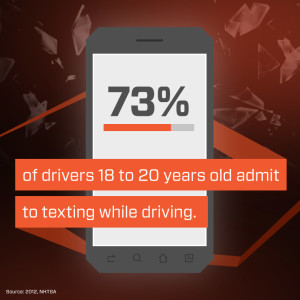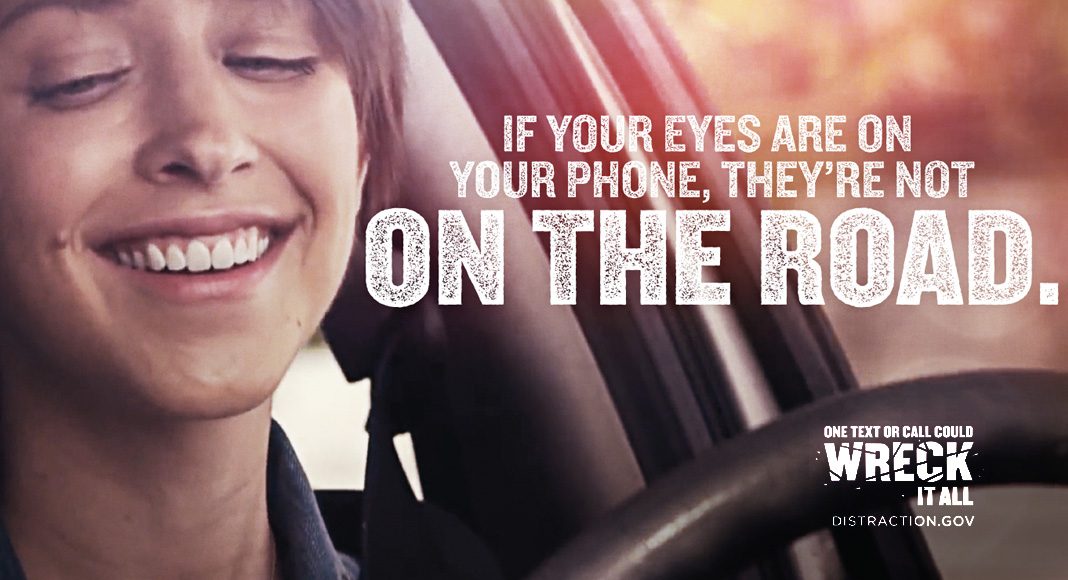The United States (U.S.) Department of Transportation’s (DOT) National Highway Traffic Safety Administration (NHTSA), the National Transportation Safety Board (NTSB), California Highway Patrol (CHP), the California Office of Traffic Safety (OTS), and Impact Teen Drivers (ITD) have joined together for the national kickoff of Distracted Driving Awareness Month.
In 2014, 3,179 people were killed and an additional 431,000 were injured in collisions involving distracted drivers in all 50 states, the District of Columbia, and Puerto Rico. That same year, inattention collisions resulted in the death of 104 people and the injury of 11,436 others in California.
“Behind every distracted driving death is a story of loss. In the blink of an eye, lives can be transformed forever.”
“Scrolling through song lists on a cell phone, or texting while driving is not just irresponsible, it can have tragic consequences. We’re calling on drivers to put down their devices and help keep the roadways safe for all Americans,” said U.S. transportation secretary Anthony Foxx.
Federal, state, and local law enforcement will be out raising awareness about the dangers of distracted driving to change behavior and save lives. The month kicks off with a national advertising campaign and law enforcement crackdown called U Drive. U Text. U Pay that runs from April 8 to April 13. The campaign is aimed at combating distracted driving nationwide and the effort includes television, radio, and digital advertisements. Drivers caught texting or using their mobile devices when behind the wheel will be issued citations in states with distracted driving bans.

“Lives are at stake on our highways. NHTSA wants to drive behavior change, stop bad habits, and encourage safe driving,” said NHTSA administrator, Dr. Mark Rosekind. “People need to understand the potential price of distracted driving. The cost of a ticket is nothing, compared to the irrevocable cost of taking someone’s life.”
To support these efforts, OTS will also conduct a social media campaign urging drivers to Silence the Distraction. According to data from the CHP’s Statewide Integrated Traffic Records System, 22,306 people were involved in distracted driving collisions in 2013. The number of distracted driving victims in California increased slightly in 2014 to 22,652.
“As we rely on our cell phones more and more in our everyday lives, we seem to be kidding ourselves in thinking that they don’t affect our driving,” said OTS director Rhonda Craft. “Crashes are up. The scientific evidence is solid. The dangers are real, and they apply to all of us. We need to silence the distractions.”
A 2014 study by the American Automobile Association Foundation, based on actual behavior rather than law enforcement reports, found that distraction due to cell phone use is much more prevalent than is reflected in official government statistics. “Our investigators can determine if speed, alcohol, or drugs were a factor in a collision,” CHP Commissioner Joe Farrow said.
“However, it is difficult to determine when distracted driving is the cause. Most people do not declare that they were distracted before they crashed. Therefore, we know distracted driving statistics are underreported.”
“Distracted driving is a completely preventable cause of death or injury on our roadways. We believe education can be as important as enforcement in addressing this problem, which is why we are pleased to have our traffic safety partners and other law enforcement agencies working with us,” Commissioner Farrow added.
https://www.youtube.com/watch?v=O8MQV40pOtk?rel=0
California Teen Safe Driver Week, April 4-10, will focus especially on the education of teen drivers. Nationally, in 2014, 13 percent of all distracted drivers involved in collisions were teenagers (age 15-19), the U.S. DOT reports.
“Driving a car is one of the riskiest activities any of us undertake on a daily basis and it is especially dangerous for our most novice drivers – teens,” Kelly Browning, Ph.D., executive director of ITD, said. “For the first time in over 50 years, traffic deaths have increased eight percent despite decades of vehicle design improvements and traffic safety advancements. Simply put, we need to change our behavior behind the wheel. We need to keep both hands on the wheel, both eyes on the road, and our minds on driving. Focus on the road ahead to get to where you’re going safely – we all have loved ones counting on us.”



















